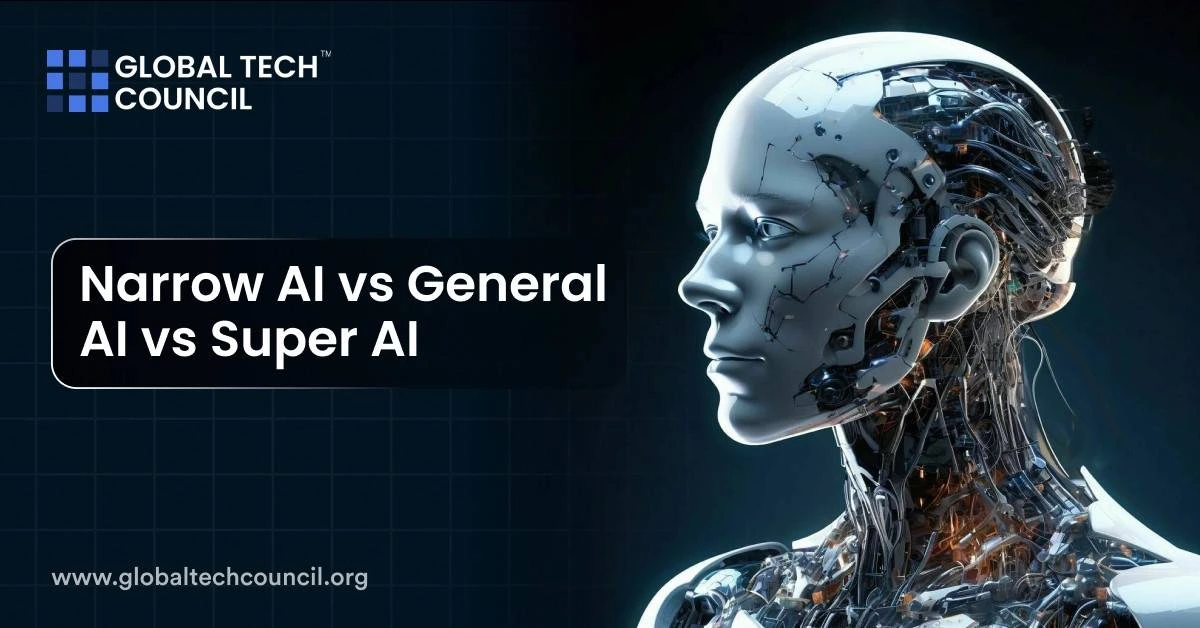Artificial Intelligence (AI) has evolved significantly over time, becoming an essential part of both everyday activities and research. Terms like “Narrow AI,” “General AI,” and “Super AI” highlight different stages in the growth of AI, each bringing different abilities and purposes.
What is Narrow AI?
Narrow AI, also referred to as “Weak AI,” is the most common form of AI today. These systems are programmed to focus on specific tasks, such as speech recognition, playing games like chess, or tagging images. They operate within set boundaries, performing exceptionally well in one function but lacking the ability to adapt or learn beyond that.
For example, virtual assistants like Siri and Alexa are forms of narrow AI. They follow preset commands to respond to your voice and help with tasks, but they don’t “think” or reason like people do. Another example is Netflix’s recommendation engine. It suggests shows based on your viewing history, but it cannot apply that information in a different context outside its designed purpose.
Narrow AI is effective, fast, and can even outperform humans in certain specific areas. However, one of its biggest drawbacks is that it can’t adjust or improve beyond what it was created to do. It’s not capable of learning anything outside its original design. Still, despite these restrictions, narrow AI is essential in areas such as healthcare, finance, and transportation. But it can’t go beyond the specific task it’s built for.
What is General AI?
General AI, often called Artificial General Intelligence (AGI), is viewed as a step up from narrow AI. AGI aims to create machines that can handle a wide variety of tasks, much like human intelligence. Unlike narrow AI, which excels in one particular area, general AI would be able to learn, reason, and adapt across multiple domains, much like a person can.
For instance, a general AI system could write an essay, solve math problems, or even learn new skills, all without needing to be reprogrammed. It would understand things like context, creativity, and ambiguity—areas where narrow AI falls short.
Although the idea of general AI is appealing, it is still mostly a theory for now. Researchers are striving to build systems that can handle tasks with the same flexibility as humans, but this presents a number of challenges. General AI would need to process information as humans do, and be capable of solving new and unexpected problems.
A good way to imagine general AI is by picturing a robot capable of doing several jobs without reprogramming. It would approach new challenges with the same reasoning that a human would, drawing from experiences in different areas. This kind of AI could revolutionize industries like medicine or law, but it’s still a work in progress.
What is Super AI?
Super AI, also called Artificial Super Intelligence (ASI), is the most futuristic form of AI, and for now, it only exists in science fiction. Super AI would not just match human intelligence, but go beyond it, excelling in every possible way—from creativity to emotional understanding and problem-solving.
Unlike general AI, which aims to mimic human-level abilities, super AI would operate on a level that surpasses human reasoning. It could, theoretically, find solutions to problems that people struggle to solve today, such as curing complex diseases or addressing global environmental issues.
However, the possibility of super AI raises many ethical and philosophical questions. If we ever reach this stage, we would face issues around control, safety, and the societal impact. Would a super-intelligent machine act in humanity’s best interests, or develop its own goals? Many experts believe that strict regulations would be crucial in ensuring that super AI remains beneficial to society.
Key Differences Between Narrow AI, General AI, and Super AI
- Scope: Narrow AI is limited to one task, general AI could handle tasks across various fields, and super AI would exceed human abilities in every way.
- Abilities: Narrow AI is excellent at specific functions but can’t adapt. General AI would be able to reason and learn across many tasks, and super AI would surpass human cognition in all aspects.
- Current State: Narrow AI is already in use today, while general AI is still in development, and super AI remains hypothetical.
- Implications: Narrow AI is helpful but limited, general AI could reshape industries, and super AI could either solve global problems or create new challenges.
Challenges and Ethical Considerations
As AI keeps evolving, ethical concerns are growing more important. Even narrow AI raises problems like biased algorithms or the risk of job displacement. These challenges could become more significant with general AI, especially as machines take on tasks that currently require human decision-making, such as those in healthcare or legal systems.
Super AI, if it ever becomes a reality, would introduce even more serious ethical questions. How would society manage a machine that is smarter than any human? Issues like international regulation, safety, and the role of AI in society would need thorough discussion and preparation.
Conclusion
That said, narrow AI is what we use today—effective but restricted in its abilities. General AI represents the hope of creating machines with the same intellectual range as humans. Super AI is a speculative idea, where machines could exceed human intelligence entirely. Each stage offers different opportunities, but they also come with unique challenges. The future of AI, whether it advances towards general or super intelligence, must be carefully developed to ensure positive outcomes for society.
